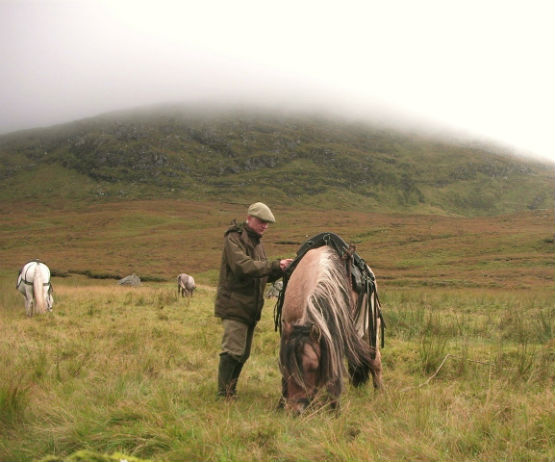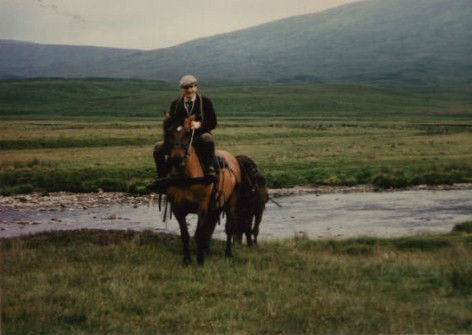Andy Hurrell reminisces about his days working the ponies as a Stalking Ghillie in the Scottish Highlands and compares them to a more recent contract in Sutherland.

(Above: Andy Hurrell in Sutherland 2013)
At the age of fifty-seven, the response that I'd come to expect when I applied for work was no response at all, so I was pleasantly surprised last summer to be offered a nine week contract as a stalking ghillie on a large deer forest in Sutherland, north-west Scotland. My credentials were a bit thin - they hinged almost entirely on the fact that in the late 1970s I worked three red stag seasons as the ponyman on Braeroy estate in Inverness-shire - but despite my rather flimsy CV, I found myself on a hot date with Lady Luck.
As far as I could tell, not much had changed in the thirty years since I last trudged round the Scottish hills with a couple of garrons in tow: highland midges are still terrifying, ponies are still quirky, rain still finds its way inside your so-called waterproofs and deer still run away if you get upwind of them.
Before the season started last year I worried that I wouldn't be fit enough to survive the necessary miles of walking over rough ground. As a young man I was never particularly fit - the only sports I persevered at were road cycling time-trials and table tennis: so, even in my twenties, five consecutive days, sometimes six, of arduous hill-walking at Braeroy left me feeling pretty stiff - how would I manage in Sutherland after a thirty-three year sabbatical going soft in the south-east of England?
Lady Luck favoured me for a second time - for a variety of reasons the work rate in Sutherland turned out to be nowhere near as relentless as it had been at Braeroy. For one thing, Gordon Addison, the stalker I worked with in the 1970s, was a two-legged non-stop industrial area and as tough as boot tackets. When he wasn't stalking deer or harassing foxes he'd put in a full day shepherding the estate's flock of 2,000 blackface ewes. Amazingly, the seasonal deer cull quota on his 25,000 acre patch was ninety stags and one hundred and twenty hinds. Almost all the stags were shot by paying guests whom Gordon took out five (sometimes six) days a week. He was assisted by a single ponyman.

(Above: The author testing a pack saddle at Braeroy in 1980)
Lest any incredulous readers suspect that this awesome work rate is no more than a figment of sixth-decade false memory syndrome, or halcyon days viewed subjectively through a rose-coloured spyglass, let me assure them otherwise. I have Gordon's diary for 1977 and I can see his day-to-day records for the stag season. And neither was there any of that anecdotal hang-out-of-the-bedroom-window-at-dawn-to-wack-a-couple-of-feeders caper that one sometimes hears of: Gordon worked his long woolly socks off. The first day of stag stalking at Braeroy in 1977 was Tuesday August 9th. Our guests were Messrs Dick and Martin, the estate owner's two brothers. They each bagged a stag, south of the river. One weighed-in at 176 lbs and the other, quite a small one, at 141lbs. During the third week of October, the last week of the Scottish season, nine stags were harvested in four days.
We did a lot of walking at Braeroy. A few of our guests struggled with it, usually those of Teutonic origin who were more used to perching in high seats, but our clients were mostly regulars or old hands who knew what they were letting themselves in for. A quad would have been an unusual sight in the highlands during the late 1970s, although the now ubiquitous Argocat had already began to make its mark. But in those days, Braeroy was run on a shoestring and we had no ATV. The only vehicles at our disposal were two disreputable looking Landrovers. In particular, the shepherds' was a picture of mobile dilapidation - it even sported a bumper crop of moss growing in the windowsills. Off road, the stalking parties relied entirely on leg power: the stags were brought down off the hill in the traditional manner, by ponies. In the afternoons, when we'd returned from the hill to wherever we'd left the Landrover in the morning, we offloaded the stags into a trailer, put the saddles into the back of the vehicle and towed the trailer back to the larder, as much as six miles down the glen road. The ponies cantered back to their field unsupervised, though we sometimes had to holler at them to keep them going. When we arrived at their paddock I'd jump out of the Landrover, let them in and shut the gate behind them. They were very obliging workmates.
We had six ponies which we worked in rotation, two, sometimes three at a time. Ginger, a scrawny chestnut gelding, was the oldest. His black mane was so ridiculously long I used to wonder how on earth he managed to see where he was going. He had a foul temper, but once we'd got the stag strapped onto his saddle he could be trusted to find his way back to base in double-quick time. By contrast, May, was a sturdy docile mare, not a pure Highland pony, rather long in the leg. She was absolutely safe as a riding horse and she saved me many miles of footslogging in the mornings as we worked our way eastwards up the glen road. May's dapple-grey daughter, Mayfly, was also rideable, but not as cool-headed as her mum. Fly, a half-sister of Mayfly, was almost a strawberry roan. I always thought of her as a big ditzy blonde, but she carried a stag well enough. Roy was a classic white highland pony, stout, solid muscle. I remember he had a curious pink patch on his upper lip. In an effort to keep my boots dry I once attempted to hitch a lift with him across the Agie burn. Halfway across he stopped and refused to continue until I'd jumped off.
Keppoch arrived at Braeroy soon after I did. He'd come from a farm near Roybridge. I was with him the day he carried a stag for the first time. Gordon blindfolded him by tying a jacket over his head. He then rubbed some heather in stag's blood and held it under Keppoch's nose for a few seconds. We tightened the girth straps and loaded the stag onto the saddle. Gordon took the lead rope from me and told me to stand well out of the way. He took the coat off Keppoch's head, backed off as far as he could and then gave the lead rope a tug. Keppoch went ballistic. He kicked like mad, then raced round in circles while Gordon stood his ground in the centre, like a tweed-clad ringmaster, clinging grimly to the lead rope. After a couple of circuits Keppoch quietened down, accepted his lot, then carried the stag home like an old trouper.
My friend Maggie says that horses are the only animals I truly like. She might be right. I'm certainly not very fond, for example, of cats. Indeed, I sometimes think of Maggie's Persian cat - a repulsive bundle of ginger fuzz with several personal hygiene issues - as my very own feline Nemesis. But last year, on the deer forest in Sutherland, I found myself working with both horses and cats - not cats of the feline variety, but Argocats, the Canadian sit-in skid-steering All Terrain Vehicles that have become the industry standard in the Scottish highlands. I shall be offering a perspective on the relative merits of ponies and Argocats in a subsequent article.
To read the second part of Andy Hurrells memoirs click on the following link: pony-tales-part-2-memoirs-of-a-ghillie



















